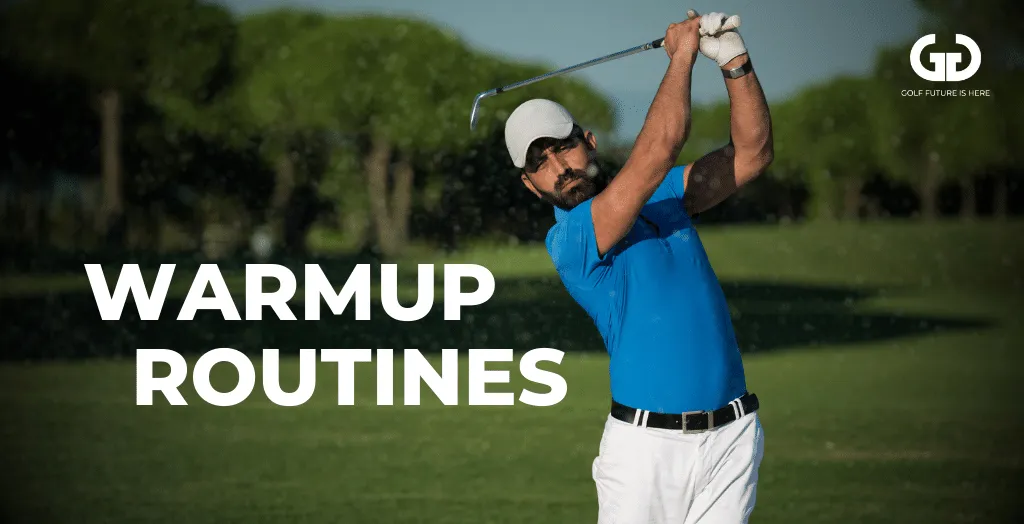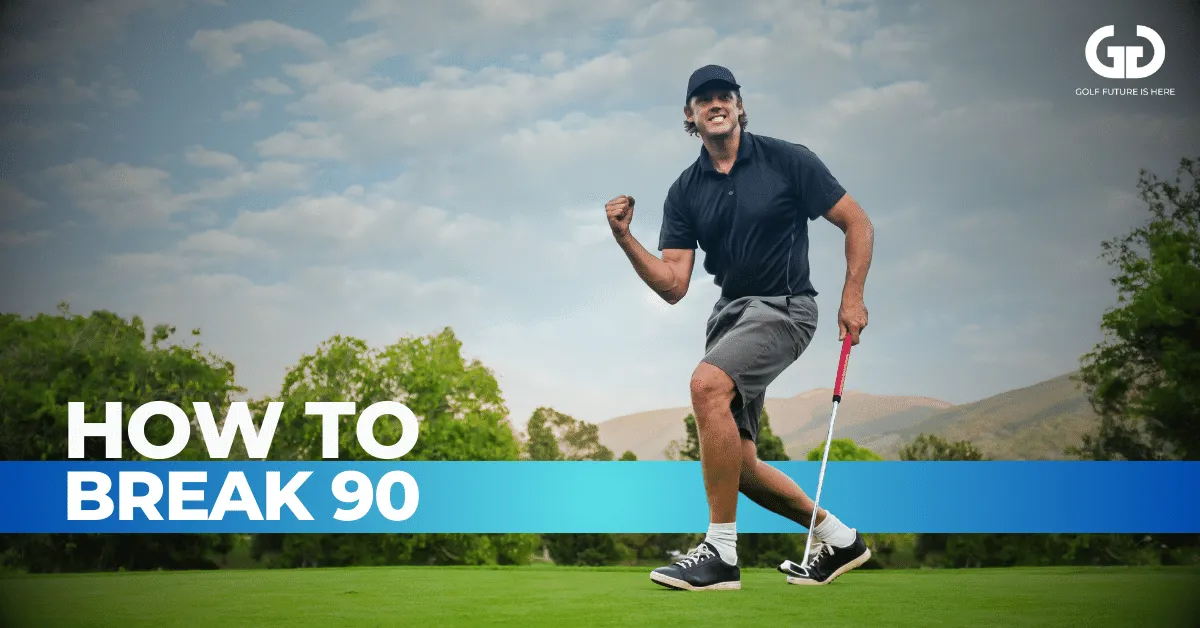Golf is a game that presents a new set of challenges every day. It isn’t easy for those with low handicaps as well. However, when you set goals in stages and achieve them, it boosts confidence.
After you have reached the goal of breaking 100, your new challenge is to break 90 in golf. While it demands a competitive spirit, it’s different from the previous goal.
For breaking 90, you focus more on the non-mechanical, and less emphasis should be on mechanical aspects. This implies that you must focus less on the swing and work smartly.
As a golfer, I’ve always focused on the non-mechanical elements at the beginning of my journey, which is why it took a long time and two failures to break 90.
Minimizing strokes, reducing putts, and adopting a unidirectional approach play a crucial role. At this stage, using a small bucket and practicing with a comprehensive approach makes sense.
There’s a lot more to it, so let’s embark on the journey to make it easier!
Key Takeaways
- You’ll have to create a pre-shot and short-game routine to improve your accuracy and control in golf.
- It is recommended to warm up before your golf match to get your body and mind ready for a thrilling performance.
- Use respective clubs for different shots and avoid hazards to minimize penalty strokes.
- Work on your wedge skills to make your short game better.
19 Tips To Break 90 In Golf
Breaking 90 isn’t a cakewalk, even if you are a medium handicap. Apart from fundamentals, swing, and alignment, there’s a comprehensive approach you should follow.
Please read the guide thoroughly and implement it accordingly to make things easier!
1. Create Pre Shot And Short Games Routine
When you want to break 90 in golf, you are already a lot better at playing your swings. You must have achieved the milestone of breaking 100 in golf. But so do your fellow players.
Thus, it’s natural for two if you should possess a similar swing. Yet, breaking 90 is less about swings and more about accuracy. Therefore, by having a pre-shot routine, you can master your gameplay.
A pre-shot routine includes planning your position, placement of the ball, hitting angle, practicing swings, and such aspects for your gameplay. It lessens your game time, minimizes slicing, and has more precision, thus one of the best practices.
Do you recall the adrenaline rush when the ball is near the green, and you have pitch, chip, or similar?
Such shots are pretty challenging to master, and hitting them in one try is like a miracle for high handicappers. The sole reason is everyone emphasizes the pre-shot routine but doesn’t bother about short game routines.
Here’s where your real test lies. Chipping and pitching are challenging to control because they need higher accuracy and practice. Thus, you should have short games and pre-shot routines
2. Upgrade Your Golf Clubs
It’s not a necessary step and is not about buying a new golf club set, but it talks about using the right kind of golf clubs. Thus, you must check your clubs for two aspects and upgrade if required.

Driver Loft
Whether you are an amateur or veteran, drivers with greater loft are always a bonus. It reduces the smash factor and even slicing.
When you choose a driver with more loft, it maximizes forward spin and also promotes tighter shots. Thus, you are less likely to miss a shot.
Further, it also promotes slower swing and club speed, which consequently helps with distance and provides accuracy. A greater loft will help you with better Shots. They should have a minimum of 9 degrees of loft.
Though most of the drivers are customizable with club tools, you can experiment with more significant loft drivers that suit your sport.
Iron Lie Angle
It is the angle that the club shaft makes with the ground. However, you must ensure the angle is correct according to your wrist-to-ground ratio. Initially, all iron angles are approximate, but even a 1-2 degree difference causes considerable misery.
A lower lie angle is called flat, while a lather that standard is known as upright. It has a larger impact on shorter Irons and a lesser impact on longer Irons.
If you possess an upward swing and your driver has standard angles, the misses would be more toward the left.
Similar is the case with flat swing and standard angles, causing misses on the right. Thus, you should contact a certified club fitter to adjust the iron lie angle per your wrist-to-floor ratio.
Thus, when you are less likely to miss any shot, you are more likely to break 90 in golf.
3. Use More Forgiving Clubs
A rule of thumb is always to buy forgiving clubs. These pieces of equipment are designed to minimize the impact of poor shots and even reduce slicing.
They have a low and deep center of gravity that facilitates high-launching shots, increased spin, and elevated drop and hop spin.
4. Use A Regular Or Senior Flex Shaft
At this stage, you are not a low-handicap golfer, and you don’t swing fast but rather slow. So, you should go for a regular or Senior Flex shaft.
This affects how the club hits the ball. In short, it is designed to hit the ball harder and faster despite your speed. Besides, the ball also goes higher and farther.
Therefore, go for a flexible shaft instead of a stiffer shaft. The latter makes it harder to hit the ball properly and increases misses, so your ball goes lower and on a short range.
Having a senior shaft flex or a regular one doesn’t mean that your ball will sink into the hole in one stroke, but it will make it easier by reducing the total strokes to two.
5. Practice With A Purpose
Whenever practicing golf, you should always do it directionally. Practice doesn’t mean swinging with a jumbo bucket; it is a comprehensive series that involves warm-up, pre-shot routine, playing on the range, and then on the course.
Moreover, don’t forget to set your mindset and be consistent. By the end of the guide, you will be familiar with what you should do at each practice stage.
6. Use A Launch Monitor
Practicing and analyzing your shots after each game is tedious and gives approximate results. You cannot be accurate in your observations or an instructor. Here’s where the launch monitor helps.
It’s a handheld device that gives you the status of the ball speed, club speed, carry, spin rates, smash factor, launch, and more. Thus, it helps to improve your swing, know the distance to the hole, and much more.
In short, it helps you stay ahead of your peers by making breaking 90 in golf easier.
7. Warm Up Routines Should Be Consistent
Apart from having a pre-shot routine, having a proper warmup routine is essential. While many golfers already follow it, they directly jump to the action part without required exercises, making it ineffective.

So, when trying to master your game, you should have at least 30 minutes of a warm-up routine. Even for golf matches, it is preferred.
Here’s what you have to do in 30 minutes:
- 3 minutes: Stretching exercises
- 7 minutes: Hitting with wedges, mid-irons, hybrids/Fairway woods, few drivers
- 10 minutes: You should Practice Chipping and pitching. Also, notice the spin and how many chips roll out after touching the ground.
- 10 minutes: Practice short-range Putts and focus on monitoring speed on the Greens.
If you have higher energy, you can even go for a 45 or 60-minute warmup routine, yet that can make you lethargic. Further, despite your warm-up duration, Practice it more frequently, like daily or weekly.
8. Make Your Tee Shots Better
To break 90 in golf, you must minimize misses and be more consistent with Shots near the green or into it. Thus, you should focus on improving Tee Shots.
A good Tee shot would make your game consistent, while a bad one can break it for a longer time. It’s because it owes to self-esteem as well.
But improving Tee Shots doesn’t mean hitting directly on the green. Though it’s a milestone, it’s a pretty cumbersome practice that takes years to develop and not at this stage.
You should focus on hitting your ball on the safer side of the green instead of going out of bounds or off the tee. Therefore, minimize misses and play on the safer side. A Fairway wood or iron would be the best for the purpose.
9. Have A Smart And Ideal Approach Strategy
Having the ideal approach is essential to break 90. Therefore, you should know the ratio to achieve this goal; you don’t need to hit every hold or not even 50%.
Your goal should be to avoid misses and play long-range. Hence, go for the shots that you can and should not. It is okay if most balls need 2 Shots and some need 3 for the green.
You won’t nail the game with a 4 or 5 handicap. You should be more consistent in your shots than rule the game in the first shot and mess up with the second.
10. Shorten Swing
You have to swing less than your ability, which helps you avoid hitting the ball in the wrong direction.
Further, you hit the ball with the right part of the club, especially if your swing is shorter and more straightforward.
Though your ball goes less far, the ball transits more straight. This way of swinging is good when you find hitting troublesome and are more likely to miss shots. It’s a way of scrambling by which you achieve consistency.
11. Minimize Penalty Strokes
When your shots go into a Penalty hazard, it leads to Penalty Strokes and negatively impacts your game. Therefore, avoid penalty strokes.
No one does it on purpose, yet there’s one thing you should know. Always play with the club, which can sink into the green.
Sometimes you think you cannot play with the driver; you can use Irons or Woods at that time. Nothing is wrong unless it messes with your game.
12. Have A Correct Mood And Mindset
Several moments in the game would frustrate you. The core step is not to bother yourself over an awful shot.
You need to relax and take it constructively. However, the aim is to break 90 in the game but play to enjoy it and not to achieve it.
Having a joyous mood would elevate your spirits, and you would be more active in it. That’s because here we are not merely playing but enjoying and can achieve a lot.
Besides, there are certain odd situations in the game, and then, too, you must learn not to give up and keep hustling.
Do you know about the 13 Benefits of Playing Golf? If not, then read about how this sport can make your life better here.
13. Mixing Up Practice Shots Daily
Practice is one of the critical things that you do to master, no matter what sport it is. However, most golfers practice only random shots and don’t have a target.
Such wrong directional practice brings up no results. Hence, you should practice different types of golf shots daily, putting special emphasis on recovery shots.
Alignment Practice
The most pivotal thing for playing golf is to check your golf. For it, grab your club and monitor the target.
Go through your full-swing routine, but before executing, analyze your alignment. Therefore, first, check shoulder alignment and then put the club on the ground at your feet line.
Take your swing only if you are square to your target; else not. Most of you would be shocked that your alignment wasn’t proper. It happens most of the time that it would surprise you that your alignment was wrong.
Routine Practice
Routine practice is something that most players don’t do; hence, it would set you apart from competitors. As you practice a full routine for each shot, use a small bucket rather than a medium or large one.
This is because full-shot routines take longer. At this time, you should focus less on mechanical and more on your aim and routine.
Check Out: How To Hit A Stinger Like A Pro: Learn The Easiest Method
Three Club Practice
When mixing practice shots, you should have a trio of clubs to have diversified training. But don’t randomly select the three clubs.
The ideal practice is to go for a driver, putter, and sand wedge. They are the most used clubs, and their different uses for varied purposes help a lot.
Below-mentioned are their applications and roles in breaking 90:
- Driver: Helps you achieve consistency by swinging a correct tee shot.
- Putter: At this stage, you won’t be able to hit the shot straight into the green. Therefore, you need two or three balls to do so. Further, the putter helps you to hit the ball onto the green when it is nearby.
- Sand Wedge: When it comes to Bunker shots or other short-range shots, a sand wedge is the ultimate rescue.
Thus, by practicing with a mix of these clubs, you can take your golfing skills to the next level.
On Course Practice
Most golf instructors emphasize practicing on the range rather than over the course. However, at this stage, the reverse is true.
You need to aim higher and be better in a shorter time. Thus, spend your time practicing on the course.

It would help you learn more about course management strategies and be better at Bunker shots. You can focus more on the targets and analyze the real-time scenario.
So, if you are fortunate enough to have a membership, you must emphasize learning on the course.
You become better at hitting full-swing shots from various slopes over the trees, and you have more fun.
14. Prepare A Backup Plan To Escape Trouble
When preparing a backup plan to escape troubles, you must be well-versed with recovery shots so they don’t affect your game.
In golf, recovery shots are essential for breaking 90 and scoring well in unfavorable situations. You have to analyze the situation and position yourself accordingly and carefully.
There are several recovery shots depending on the tricky scenarios.
Punch Shot
A punch shot is a low-trajectory shot that you should hit to keep the ball under tree branches. Besides, you should also use it when there are strong winds.
To execute a punch shot, use a shorter backswing, a slightly closed clubface, and a descending strike on the ball. This shot helps keep the ball flight lower.
Hence, it reduces the chances of hitting obstructions, and even winds don’t affect it.
Bump-and-Run
A bump-and-run shot is a low-risk shot that usually lies along the ground. To a greater extent, it avoids obstacles and helps even if there’s too much greenery.
Use a less lofted club, such as a 7-iron or 8-iron, and play the ball back in your stance. The goal is to make a short, controlled swing, allowing the ball to roll toward the target once it lands on the green.
Flop Shot
When you want to hit the ball high and stop it quickly due to a Bunker, a tight pin position, or too little green, a flop shot is the ultimate rescue.
Open the clubface significantly, aim left of the target (for right-handed golfers), and swing with a steep, accelerated motion. This will produce a high, soft shot that lands softly and stops quickly.
Explosion or Splash Shot
When in a greenside bunker, a critical recovery shot is the explosion shot or the splash shot. Open the clubface, aim slightly left (for right-handed golfers), and enter the sand a couple of inches behind the ball.
The goal is to make contact with the sand, allowing the club to slide under the ball, resulting in a high, soft shot that lands on the green.
These recovery shots are required in deep rough, trees, or other challenging situations. The specific shot will depend on the circumstances.
Yet options include punching out sideways to a more favorable position and hitting a controlled fade or draw to navigate around obstacles.
You can even use a club with a greater loft club to elevate the ball over obstacles.
15. Improve Wedge Skills
After drivers, wedges are your next good friend. By improving your wedge skills, you can become accurate with approach shots and even gain consistency.
You can use it to hit shorter shorts within 100 years of the hole. Further, as they provide greater accuracy, you would need fewer pits, which increases the probability of sinking shots and avoids non-essential strokes.
With different wedges and knowing how to hit the ball with each of them, you can adjust the distance control. This lets you choose the apt club and adjust your swing with the required disable. So it avoids overshooting.
Wedges help with bunker shots, especially sand shots. You can use it to hit shots out of sand bunkers. By enhancing your wedge skills, you become more familiar with and learn the correct technique for hitting bunker shots.
These include using its bounce and making clean contact with the sand. In this way, you escape bunkers easily and save your strokes.
Master short games require versatile Chipping, pitching, and bunker play. The wedges help for the purpose. Hence, by acing your wedge skills, you can better gain expertise around shorts near the hole. Thus, the ball closer to the green would be more likely to sink.
Improving wedge skills thus helps with better approach shots, improved distance control, effective bunker play, and Short game mastery.
By reducing errors and maximizing scoring opportunities, you can lower your scores and increase the likelihood of breaking 90 in golf.
16. Learn Chipping
My chipping game was once too weak, which brought inconsistency in play and even increased the number of strokes. That’s the reason why I failed to break 90 in golf twice.
But with a short game routine and mastering Chipping, I’ve honed my golf skills, and so I was able to achieve my short-term goal of 90.
17. Increase Your Speed On The Greens
A lesser-known fact is that you must increase your speed on the Greens to break 90. However, you must balance control and speed to avoid misses. Increasing speed means hitting the ball harder, with plenty of benefits!
Distance Control
When you hit the ball harder, it travels farther and thus helps further long-range shots. You have to put in less effort to let it sink, and it reduces your strokes as well.
Roll and Break
With increased speed, your ball follows a smooth path despite the obstacles. Thus, it minimizes the impact of bumps and slopes, which avoids obstacles on the path. This helps you to adjust the ball’s trajectory better.
Uphill Putts
During uphill putts, if you hit the ball harder, it reaches the hole in less time. It is thus a rescue as uphill putts otherwise slow down readily.
Downhill Putts
Downhill putts are less risky for many of you. However, you would have experienced them often rolling too far from the green. Thus, if you hit it hard for more incredible speed, it controls the ball properly and prevents transit too far.
Besides, with greater speed on the greens, you are more confident with your ventures towards breaking 90 in the golf game.
18. Shape Your Shots
Shaping shots might seem tricky in the beginning, but it is a rescue otherwise. When you shape your shots, you don’t swing them merely from left to right, but they can be in other directions and angles as well.
This is because shot shaping involves the height of the ball from the ground as well. When you shape your shots, you can escape challenging situations easily and master the game.
19. Avoid Blow Ups As Much As Possible
Blow-ups in golf aim to avoid mistakes that can ruin your gameplay and prevent you from breaking 90 in golf. Thus, you shouldn’t make mistakes that lead to inconsistent gameplay for the entire round.

For example, hitting out of bounds or into sand or water can lead to penalties and additional strokes if not appropriately handled.
Moreover, missing short-range shots, which you cannot play but you give a try as you think you should, can cost you a lot.
Hence, avoid blow-ups and make smart decisions to avoid such mistakes in the game. So it doesn’t spoil your overall performance.
The Final Word
Breaking 90 doesn’t require being a hard-core golfer, but you should have a never-give-up attitude. Before anything else, you must have a joyous mode and a proactive approach to the game.
Your thoughts shouldn’t stumble upon the goal, but have a sportsmanship spirit and enjoy the game. The first step is to have a warm-up, then follow a pre-shot and short-game routine. Next, practice on the range with a small bucket and then on the course.
During any of these times, don’t think about swing or any non-mechanical aspects all the time; only have one swing thought and approach the mechanical elements.
Don’t miss shaping shots and tracking your game stats. Remember that playing with Low Handicap fosters a competitive spirit, and you learn a lot.
Similarly, learn to break 80 and 100 handicaps in our detailed guide.





0 Comments